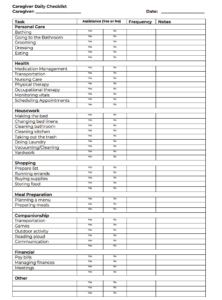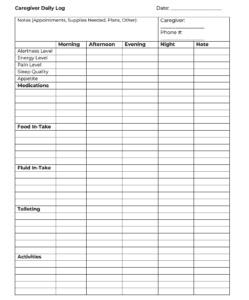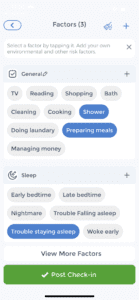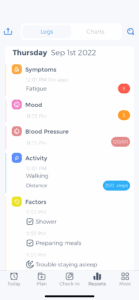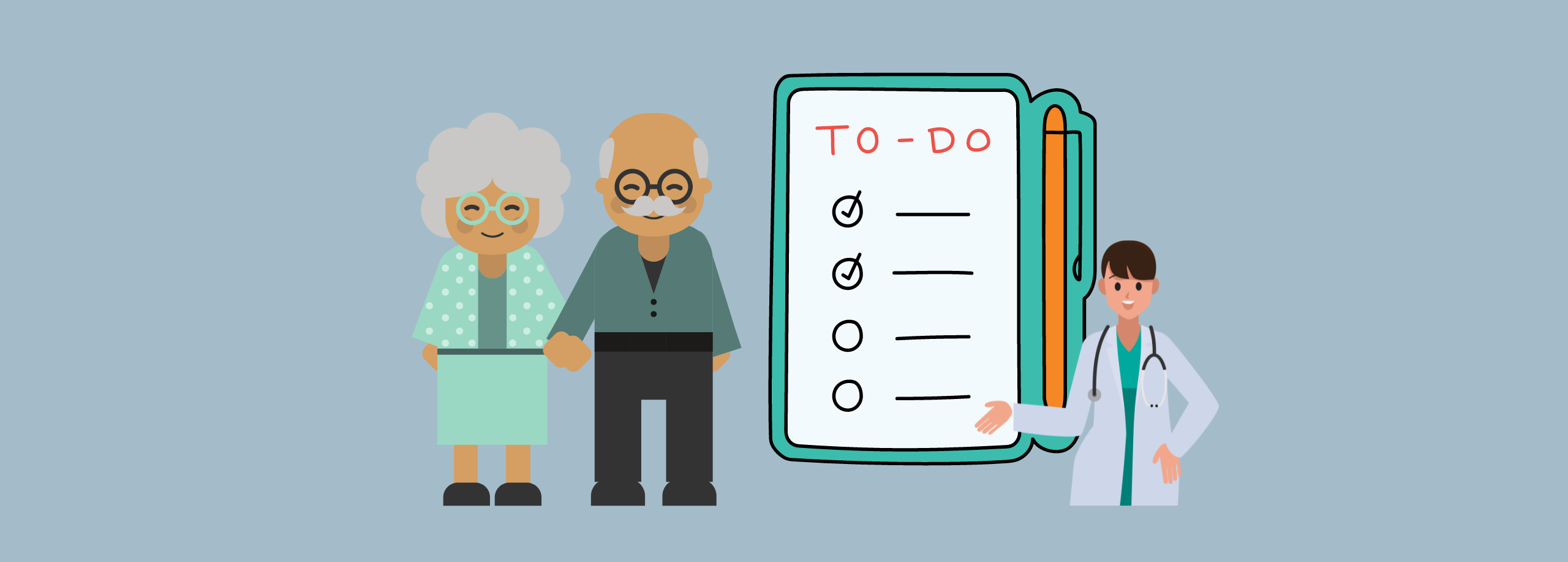 A caregiver daily log is a written record of the tasks and activities performed by a caregiver during the course of a day. The log may be used to document the care provided to a patient or client, as well as to communicate information about the individual’s needs and progress to other members of the care team.
A caregiver daily log is a written record of the tasks and activities performed by a caregiver during the course of a day. The log may be used to document the care provided to a patient or client, as well as to communicate information about the individual’s needs and progress to other members of the care team.
Table of Contents
- What are Caregiver daily logs used for?
- What is a nursing assessment?
- What is ADL and IADL?
- Who can use a caregiver daily log sheet?
- When should a caregiver daily log be used?
- What’s included in a Caregiver daily log?
- How do I create a Caregiver daily log?
- How can the CareClinic app help keep a caregiver daily log?
- Is there a printable PDF spreadsheet that can be used?
- Does a caregiver logbook help with medicine reminders and symptom tracking?
- Which other logs can be beneficial for patients to print and use?
- What are some other things that can be tracked in CareClinic?
- How do I log a dependent’s health in CareClinic as a caregiver?
- Collaborative at-home Patient Documentation
What are Caregiver daily logs used for?
Caregiver daily logs can be used to track the progress of an individual over time and to identify any areas in which their needs are not being met. They can also be used to help plan future care by providing a record of what has been done in the past and what has been found to be effective.
As an example, if a caregiver daily log shows that an individual has been particularly agitated in the evening hours, this may be used to inform the care plan for the following day. The log may also be reviewed by other members of the care team, such as doctors or nurses, to get a better understanding of the individual’s needs.
What is a nursing assessment?
A nursing assessment is a key component of the nursing process. It is an opportunity for nurses to gather information about their patients to develop a plan of care. The assessment should be comprehensive and include all aspects of the patient’s health, including physical, psychological, social, and spiritual needs. A patient assessment is usually conducted at the beginning of the nurse-patient relationship, but it can also be done at any time when there is a change in the patient’s condition. A nurse report sheet is a form that is used by nurses to document assessment data.
What is SBAR?
SBAR is an acronym that stands for Situation, Background, Assessment, and Recommendation. It is a tool that can be used to improve communication between healthcare providers. SBAR can be used in any situation where clear and concise communication is needed, such as during handoffs or when calling a doctor for consultation. SBAR can be used to improve communication between healthcare providers; however, it is not necessarily used on a caregiver log sheet.
What is ADL and IADL?
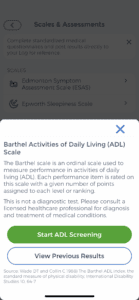 ADL stands for activities of daily living and IADL stands for instrumental activities of daily living. Activities of daily living are the things we do every day without thinking about them, like getting dressed, brushing our teeth, and eating. Most people can do these things independently. Instrumental activities of daily living are the things we do that require more effort or planning, like cooking, doing laundry, and cleaning. People who need help with IADLs may be able to live on their own but may need some assistance with these tasks.
ADL stands for activities of daily living and IADL stands for instrumental activities of daily living. Activities of daily living are the things we do every day without thinking about them, like getting dressed, brushing our teeth, and eating. Most people can do these things independently. Instrumental activities of daily living are the things we do that require more effort or planning, like cooking, doing laundry, and cleaning. People who need help with IADLs may be able to live on their own but may need some assistance with these tasks.
There are many different ways to measure ADL and IADL. One way is to use the Lawton and Brody Scale, which rates activities from 0 (unable to do) to 8 (independent). Another way is to use the Katz Index of Independence in Activities of Daily Living, which rates activities from 0 (dependent) to 4 (independent).
The type of help someone needs with ADLs or IADLs can vary from person to person. Some people may need help with only one activity, while others may need help with several activities. Some people may need help only occasionally, while others may need help on a daily basis. If you are a caregiver, you may be wondering how to best assist someone with ADLs or IADLs. One option is to provide hands-on help, such as helping someone get dressed or taking them to appointments. Another option is to provide guidance and support, such as showing someone how to use a microwave or teaching them how to budget their money.
No matter what type of help you provide, it is important to be patient, respectful, and flexible. ADLs and IADLs can be frustrating for both the person who is struggling to do them and the caregiver who is trying to help. Remember to take breaks when needed, and ask for help from friends or family members if you are feeling overwhelmed.
Who can use a caregiver daily log sheet?
It is not just for patients or clients. It can be used by teens, elderly, or anyone with a chronic condition that is being managed. It is most commonly used to track medical appointments, medications, and other treatments. However, it can also be used to document behaviors or changes in mood, sleep patterns, eating habits, and any other notable changes. It is particularly useful for those with Alzheimer’s disease, dementia, or other cognitive impairments.
When should a caregiver daily log be used?
A caregiver daily log should be used whenever there is a need to track the progress of an individual over time. This may be on a daily, weekly, or monthly basis, depending on the individual’s needs.
What’s included in a Caregiver daily log?
The contents of a caregiver daily log will vary depending on the type of care being provided and the needs of the individual. However, common information that may be recorded in a caregiver’s daily log includes:
- The date and time of each task or activity performed
- A description of the task or activity performed
- The duration of the task or activity
- Any special instructions for performing the task or activity
- Any observations made about the individual during the course of the day
- Insurance details
- Notes from doctor appointments
A caregiver daily log can replace the need for individual medication log books, or disease-specific log books for diabetes, hypertension and allergies if you are managing a dependents’ health.
How do I create a Caregiver daily log?
There are some basic steps that can be followed to get started:
- Decide what information you want to include in the log.
- Choose a format for recording the information. This could be a paper notebook, an electronic spreadsheet, or a specialized app like CareClinic.
- Set up a system for recording the information. This may involve assigning specific tasks to different caregivers, setting up times during the day when the log will be updated, or both.
- Train caregivers on how to use the system and what information should be included in the log.
- Begin recording information in the log daily.
- Review the log regularly to ensure that it is being used effectively and that all relevant information is being captured.
- If necessary, make changes to the system based on your observations.
Can a caregiver’s daily log be used for any type of patient?
A caregiver daily log can be used for any type of patient, including those receiving in-home care, those in a hospice or nursing home setting, and those in a hospital. It is common to use for in-home care patients, as it can be difficult for family members to keep track of all the tasks and activities being performed by the caregiver. However, any type of patient can benefit from having a daily log kept of their care.
If you are a caregiver, consider keeping a daily log to document the care you provide. This can be a valuable tool for tracking the individual’s progress and communicating information to other members of the care team. It can also help you to reflect on your own practice and identify areas in which you may need more training or support.
How can the CareClinic app help keep a caregiver daily log?
The CareClinic app is designed to help caregivers track the care they provide. It includes features such as:
- A customizable care plan for each individual
- The ability to record tasks, activities, and observations in a daily log
- Notes section for recording additional information
- The option to share logs with other members of the care team
- Reminders and alerts to help keep on track
If you are looking for a way to keep a caregiver daily log, the CareClinic app may be a good option for you. It can help you to stay organized and ensure that all relevant information is recorded. Plus, it’s free to download and easy to use. Try it today!
Is there a printable PDF spreadsheet that can be used?
Yes, there is a printable PDF spreadsheet that can be used to keep a caregiver daily log. This can be found here:
⤵️ Printable caregiver daily checklist template
⤵️ Printable caregiver daily log
⤵️Try Factors Check-list in App
⤵️ View Caregiver Logs in App
The spreadsheet includes columns for the date, time, task or activity performed, duration, special instructions, and observations. There is also a notes section where additional information can be recorded. This can be helpful if you want to track specific details about the individual’s progress or care. However, it is recommended that you try the app as it can keep all caregivers or families in the loop about a dependent that is being cared for.
Does a caregiver logbook help with medicine reminders and symptom tracking?
![]() A caregiver logbook can help with medicine reminders and symptom tracking in a few different ways. First, if you are using an app like CareClinic, you can set up medication reminders within the app. These will send you notifications at the times when the individual needs to take their medication. You can also use the app to track any symptoms that the individual is experiencing.
A caregiver logbook can help with medicine reminders and symptom tracking in a few different ways. First, if you are using an app like CareClinic, you can set up medication reminders within the app. These will send you notifications at the times when the individual needs to take their medication. You can also use the app to track any symptoms that the individual is experiencing.
This information can be shared with other members of the care team, which can be helpful in determining the best course of treatment. Finally, many apps also offer features like goal setting and progress tracking. This can be beneficial for both the caregiver and the individual receiving care.
Which other logs can be beneficial for patients to print and use?
There are a variety of other logs that can be beneficial for patients to print and use. These include Blood pressure, pulse log, blood sugar, heart rate, pain journal, sleep log, diet diary, activity tracker, symptom tracker and a body temperate log. It may also make sense to simply buy a workbook if you feel like a digital solution or printing sheets one by one is not the right solution for you, you can find these by clicking here.
What are some other things that can be tracked in CareClinic?
In addition to tracking medication and symptoms, the CareClinic app can also be used to track:
- Appointments and other plans for tomorrow
- Any other health concerns in notes
- Immunizations and allergies
- Vital signs such as blood pressure, blood oxygen, heart rate
- For infants: Weight and height measurements
- Diet including fluid in-take at different times of the day
- Exercise and or any other physical therapy or activity
- Sleep patterns, naps, times woken up and why
- Bathroom/stool log
- Mood and behavior
- Supplies needed soon
- Alertness, happiness, pain levels, or any measurement that is required
- CareClinic also comes with over 50 health assessments, tests and surveys built directly into the app for many health conditions
This information can help understand the individual’s overall health and well-being. It can also be useful in identifying any trends or patterns that may be emerging. If you are looking for a way to track all of this information in one place, CareClinic may be a good option for you. Try it today!
How do I log a dependent’s health in CareClinic as a caregiver?
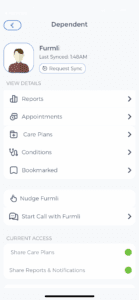 You can track the health of multiple patients in two ways in CareClinic. You can create two separate care plans, or you can have your dependents create accounts and have them add you as a caregiver, you can then have them create care plans for themselves which you can monitor remotely.
You can track the health of multiple patients in two ways in CareClinic. You can create two separate care plans, or you can have your dependents create accounts and have them add you as a caregiver, you can then have them create care plans for themselves which you can monitor remotely.
Easily Share All Details and Review Medical History
A benefit of using the app is that you can still print out all details to share with caregivers on a day-to-day basis and to share with other health care providers. The App provides pre-set trackers for each patient so there is no time wasted in thinking about what to log, how to log it, and adding new items to a care plan as the App comes with a built-in database of medications, supplements, symptoms, measurements (with units), activities, therapies, and other trackers for stool and sleep monitoring.
Improved Patient Visit Notes
Another key benefit provided by CareClinic is that you can spot patterns easily with automated charting, correlations, and logs within the App. This is not possible with a physical logbook. Another benefit is that at-home caregivers are much more inclined to quickly tap items on a screen rather than handwrite notes for patients due to time or other constraints.
CareClinic is cross-platform and works online-offline, and what that means is that the App may be left open for caregivers to quickly make check-ins for a patient as most entries will involve tapping and sliding different values. This leads to fewer mistakes, and improved communication from the caregiver filling out the details, and you are able to access it from anywhere at any time to share with anyone you may need to share it with.
Collaborative at-home Patient Documentation
The CareClinic app can be used to keep track of a wide range of caregiving tasks and activities. It is customizable to meet the needs of each individual, and it offers the ability to share logs with other members of the care team.
Plus, it’s free to download and easy to use. Try it today! It is particularly useful when there are many caregivers and everyone needs to remain updated on how a dependent is doing and what the next tasks are. This way no mistakes are made, and everything is private and can be shared safely.



